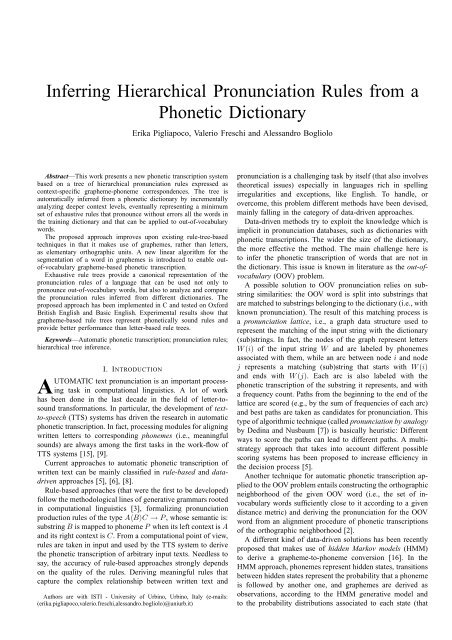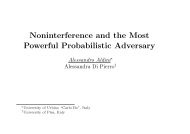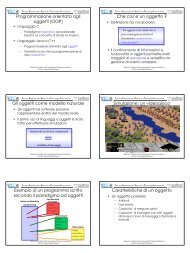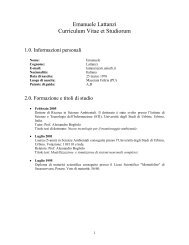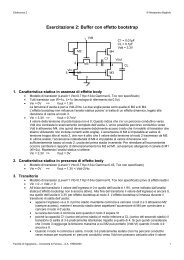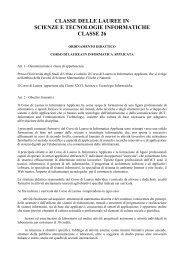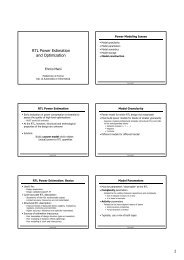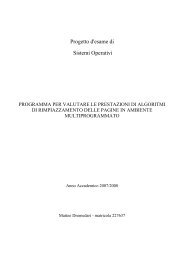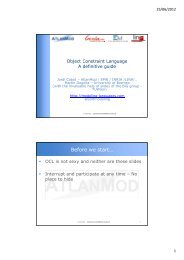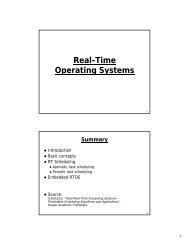Inferring Hierarchical Pronunciation Rules from a Phonetic Dictionary
Inferring Hierarchical Pronunciation Rules from a Phonetic Dictionary
Inferring Hierarchical Pronunciation Rules from a Phonetic Dictionary
You also want an ePaper? Increase the reach of your titles
YUMPU automatically turns print PDFs into web optimized ePapers that Google loves.
<strong>Inferring</strong> <strong>Hierarchical</strong> <strong>Pronunciation</strong> <strong>Rules</strong> <strong>from</strong> a<br />
<strong>Phonetic</strong> <strong>Dictionary</strong><br />
Erika Pigliapoco, Valerio Freschi and Alessandro Bogliolo<br />
Abstract—This work presents a new phonetic transcription system<br />
based on a tree of hierarchical pronunciation rules expressed as<br />
context-specific grapheme-phoneme correspondences. The tree is<br />
automatically inferred <strong>from</strong> a phonetic dictionary by incrementally<br />
analyzing deeper context levels, eventually representing a minimum<br />
set of exhaustive rules that pronounce without errors all the words in<br />
the training dictionary and that can be applied to out-of-vocabulary<br />
words.<br />
The proposed approach improves upon existing rule-tree-based<br />
techniques in that it makes use of graphemes, rather than letters,<br />
as elementary orthographic units. A new linear algorithm for the<br />
segmentation of a word in graphemes is introduced to enable outof-vocabulary<br />
grapheme-based phonetic transcription.<br />
Exhaustive rule trees provide a canonical representation of the<br />
pronunciation rules of a language that can be used not only to<br />
pronounce out-of-vocabulary words, but also to analyze and compare<br />
the pronunciation rules inferred <strong>from</strong> different dictionaries. The<br />
proposed approach has been implemented in C and tested on Oxford<br />
British English and Basic English. Experimental results show that<br />
grapheme-based rule trees represent phonetically sound rules and<br />
provide better performance than letter-based rule trees.<br />
Keywords—Automatic phonetic transcription; pronunciation rules;<br />
hierarchical tree inference.<br />
I. INTRODUCTION<br />
AUTOMATIC text pronunciation is an important processing<br />
task in computational linguistics. A lot of work<br />
has been done in the last decade in the field of letter-tosound<br />
transformations. In particular, the development of textto-speech<br />
(TTS) systems has driven the research in automatic<br />
phonetic transcription. In fact, processing modules for aligning<br />
written letters to corresponding phonemes (i.e., meaningful<br />
sounds) are always among the first tasks in the work-flow of<br />
TTS systems [15], [9].<br />
Current approaches to automatic phonetic transcription of<br />
written text can be mainly classified in rule-based and datadriven<br />
approaches [5], [6], [8].<br />
Rule-based approaches (that were the first to be developed)<br />
follow the methodological lines of generative grammars rooted<br />
in computational linguistics [3], formalizing pronunciation<br />
production rules of the type A〈B〉C → P , whose semantic is:<br />
substring B is mapped to phoneme P when its left context is A<br />
and its right context is C. From a computational point of view,<br />
rules are taken in input and used by the TTS system to derive<br />
the phonetic transcription of arbitrary input texts. Needless to<br />
say, the accuracy of rule-based approaches strongly depends<br />
on the quality of the rules. Deriving meaningful rules that<br />
capture the complex relationship between written text and<br />
Authors are with ISTI - University of Urbino, Urbino, Italy (e-mails:<br />
(erika.pigliapoco,valerio.freschi,alessandro.bogliolo)@uniurb.it)<br />
pronunciation is a challenging task by itself (that also involves<br />
theoretical issues) especially in languages rich in spelling<br />
irregularities and exceptions, like English. To handle, or<br />
overcome, this problem different methods have been devised,<br />
mainly falling in the category of data-driven approaches.<br />
Data-driven methods try to exploit the knowledge which is<br />
implicit in pronunciation databases, such as dictionaries with<br />
phonetic transcriptions. The wider the size of the dictionary,<br />
the more effective the method. The main challenge here is<br />
to infer the phonetic transcription of words that are not in<br />
the dictionary. This issue is known in literature as the out-ofvocabulary<br />
(OOV) problem.<br />
A possible solution to OOV pronunciation relies on substring<br />
similarities: the OOV word is split into substrings that<br />
are matched to substrings belonging to the dictionary (i.e., with<br />
known pronunciation). The result of this matching process is<br />
a pronunciation lattice, i.e., a graph data structure used to<br />
represent the matching of the input string with the dictionary<br />
(sub)strings. In fact, the nodes of the graph represent letters<br />
W(i) of the input string W and are labeled by phonemes<br />
associated with them, while an arc between node i and node<br />
j represents a matching (sub)string that starts with W(i)<br />
and ends with W(j). Each arc is also labeled with the<br />
phonetic transcription of the substring it represents, and with<br />
a frequency count. Paths <strong>from</strong> the beginning to the end of the<br />
lattice are scored (e.g., by the sum of frequencies of each arc)<br />
and best paths are taken as candidates for pronunciation. This<br />
type of algorithmic technique (called pronunciation by analogy<br />
by Dedina and Nusbaum [7]) is basically heuristic: Different<br />
ways to score the paths can lead to different paths. A multistrategy<br />
approach that takes into account different possible<br />
scoring systems has been proposed to increase efficiency in<br />
the decision process [5].<br />
Another technique for automatic phonetic transcription applied<br />
to the OOV problem entails constructing the orthographic<br />
neighborhood of the given OOV word (i.e., the set of invocabulary<br />
words sufficiently close to it according to a given<br />
distance metric) and deriving the pronunciation for the OOV<br />
word <strong>from</strong> an alignment procedure of phonetic transcriptions<br />
of the orthographic neighborhood [2].<br />
A different kind of data-driven solutions has been recently<br />
proposed that makes use of hidden Markov models (HMM)<br />
to derive a grapheme-to-phoneme conversion [16]. In the<br />
HMM approach, phonemes represent hidden states, transitions<br />
between hidden states represent the probability that a phoneme<br />
is followed by another one, and graphemes are derived as<br />
observations, according to the HMM generative model and<br />
to the probability distributions associated to each state (that
have to be learned during the training phase).<br />
A hybrid approach between data-driven and rule-base techniques<br />
consists of automatically extracting a set of rules <strong>from</strong> a<br />
phonetic dictionary, taking into account left and right contexts<br />
in order to reduce pronunciation ambiguity [4], [10], [11], [13],<br />
[14], [17]. In particular, the algorithm proposed by Hochberg<br />
et al. [10] is based on the alignment between characters and<br />
phonemes and it proceeds by inducing a hierarchical tree of<br />
rules that become progressively more specific at deeper levels<br />
of the tree as larger contexts are considered. Starting <strong>from</strong> level<br />
1, that provides a context-free pronunciation rule for the given<br />
letter, the algorithm proceeds by choosing a context-letter at a<br />
time and by adding child nodes to represent context-specific<br />
exceptions to the context-free rule. At each step, the most<br />
significant incremental context is chosen. Daelemans et al.<br />
[4] developed a similar algorithm that constructs a rule tree<br />
by enforcing a fixed criterion (based on static informationtheoretical<br />
analysis) for choosing context letters.<br />
This paper proposes a similar approach that infers a tree<br />
of hierarchical pronunciation rules <strong>from</strong> a phonetic dictionary,<br />
but it uses graphemes in place of letters. The result<br />
is a set of grapheme-to-phoneme (rather than letter-to-sound)<br />
associations that are directly comparable with those used<br />
in generative grammars. Moreover, the rule tree provides a<br />
canonical representation that can be used to analyze the empirical<br />
pronunciation rules (and exceptions) of a given language<br />
and to compare the rules of different languages, as exemplified<br />
in Section III-F. The depth of the tree can be limited to obtain<br />
different tradeoffs between size and accuracy. If no limits are<br />
imposed, the tree represents exhaustive pronunciation rules<br />
that read without errors all the words in the training dictionary.<br />
The proposed approach has been implemented in C and<br />
compared with the algorithm by Daelemans [4] in terms of<br />
accuracy, efficiency, and phonetic soundness of the inferred<br />
rules. Finally, the algorithm has been applied to infer and<br />
compare the empirical pronunciation rules of British English<br />
and Basic English [12].<br />
’known’). However, 〈k〉 and 〈n〉 are also English graphemes<br />
by themselves, since they occur separately in many words.<br />
Moreover, even if they appear together, they may be treated<br />
as separate graphemes as in the composite word ’banknote’,<br />
where ’kn’ has to be regarded as 〈k〉〈n〉 and pronounced /k//n/.<br />
A phonogram is a grapheme-phoneme pair where the<br />
grapheme is one of the possible orthographic representations<br />
of the phoneme and the phoneme is one of the possible pronunciations<br />
of the grapheme. Since in many languages there is no<br />
1-1 correspondence between graphemes and phonemes, there<br />
are many more phonograms than graphemes and phonemes.<br />
The proposed algorithm starts <strong>from</strong>: i) the set of the ASCII<br />
representations of the phonemes of the target language, ii) the<br />
set of the graphemes of the target language, iii) a conventional<br />
table of phonograms and iv) a consistent phonetic dictionary,<br />
i.e., a list of words with corresponding phonetic transcriptions.<br />
The phonetic dictionary is parsed and used as a training set<br />
to build a tree of statistical pronunciation rules that can be<br />
eventually applied to OOV words.<br />
A. Theoretical foundation<br />
According to our definition of grapheme, the segmentation<br />
of a word in graphemes is induced by its pronunciation<br />
through the phonogram table. For instance, given the English<br />
word ’known’ and its phonetic transcription /n//@U//n/, the<br />
phonogram table suggests that the word is composed of the<br />
graphemes 〈kn〉〈ow〉〈n〉 that are aligned to the omologous<br />
phonemes. Similarly, given the English word ’banknote’ and<br />
its phonetic transcription /b//&//N//k//n//@U//t/, the corresponding<br />
segmentation is 〈b〉〈a〉〈n〉〈k〉〈n〉〈o〉〈t〉〈e〉. These two<br />
examples point out that graphemes are not uniquely determined<br />
by the orthography (for instance, ’kn’ is split into<br />
〈k〉〈n〉 in ’banknote’ and taken as a single grapheme 〈kn〉 in<br />
’known’) and that words may contain silent graphemes (such<br />
as 〈e〉 in ’banknote’). Given a word, its phonetic transcription<br />
and a phonogram table, its segmentation in graphemes can be<br />
determined by means of a branch and bound decision process.<br />
Since the aim of this work is building a tree of pronunciation<br />
II. AUTOMATIC TEXT PRONUNCIATION<br />
rules to be possibly applied to OOV words, it is impossible to<br />
rely on the knowledge of the phonetic transcription of a word<br />
Before outlining the proposed approach to automatic text<br />
to obtain its segmentation in graphemes. Rather, it is necessary<br />
pronunciation, operative definitions need to be introduced of<br />
to obtain first the graphemes <strong>from</strong> the orthography, and then<br />
the terms ’phoneme’, ’grapheme’ and ’phonogram’, that are<br />
the phonetic transcription <strong>from</strong> the sequence of graphemes.<br />
extensively used hereafter.<br />
This can be done without ambiguity by extending the set of<br />
A phoneme can be defined as the smallest phonetic unit<br />
graphemes as outlined in the following.<br />
capable of causing a distinction in meaning. All the phonemes<br />
A grapheme x contains a grapheme y if y is a substring<br />
of a given language can be associated with a subset of the<br />
International <strong>Phonetic</strong> Alphabet (IPA) 1 (i.e., a subset of contiguous characters) of x. In this case, y is<br />
. IPA symbols are then<br />
said to be a sub-grapheme of x. The sequence of graphemes<br />
used to denote the corresponding phonemes. When ASCII<br />
P = (y<br />
characters are used in place of the standard IPA notation, 1 , y 2 , ..., y n ) is a partition of x if and only if x can be<br />
obtained <strong>from</strong> the concatenation of y<br />
phonemes are represented within slashes (e.g., /@/).<br />
1 , y 2 , ..., y n .<br />
Two graphemes x and y are overlapping if the tail (i.e., the<br />
A grapheme is a sequence of one or more characters<br />
last part) of x is equal to the head (i.e., the first part) of y. For<br />
that may be pronounced as a single phoneme. Graphemes<br />
instance 〈kn〉 contains 〈k〉 and 〈n〉, P=(〈k〉,〈n〉) is a partition<br />
are usually represented within angle brackets. For instance,<br />
of 〈kn〉, while 〈ss〉 and 〈sh〉 are overlapping graphemes.<br />
according to our definition, 〈kn〉 is an English grapheme, since<br />
G is a complete grapheme set if and only if, for each pair<br />
in many words it is pronounced as a single phoneme (/n/ as in<br />
of overlapping graphemes x and y in G, there is a grapheme<br />
1 International <strong>Phonetic</strong> Association, http://www2.arts.gla.ac.uk/IPA/index.html, z in G that contains both x and y. For instance, if G contains<br />
1996<br />
〈ss〉 and 〈sh〉, it is not complete unless it also contains 〈ssh〉.
P is a complete phonogram table if and only if the phonetic<br />
transcriptions associated with each grapheme include all<br />
combinations of the phonemes associated with the graphemes<br />
of its possible partitions. In our example, a complete phonogram<br />
table associates to grapheme 〈kn〉 not only its singlephoneme<br />
prononciation /n/, but also the concatenation of the<br />
possible phonemes associated with 〈k〉 and 〈n〉, such as /k//n/.<br />
Hereafter, the concatenation of the phonemes associated with<br />
a single grapheme is represented by a dot, and the resulting<br />
sequence of phonemes is treated as a single phoneme (/k.n/).<br />
A partition P of a given word w, defined over grapheme<br />
set G, is a said to be a minimum partition for w if it contains<br />
the minimum number of graphemes.<br />
Theorem 1. Given a word w and a complete grapheme set G,<br />
the minimum partition P of w defined over G is unique and<br />
it can be incrementally constructed in linear time during the<br />
parsing of w.<br />
Proof. The uniqueness of the minimum partition P can be<br />
demonstrated by assuming, by contradiction, that there are<br />
two different minimum partitions (namely, P1 and P2) of the<br />
same word w. In order for P1 to be different <strong>from</strong> P2 there<br />
must be at least a character c of w that is considered to be<br />
part of different graphemes in P1 and P2 (namely, g1 and<br />
g2). Since the two graphemes cover the same character c of<br />
w they must be either contained in each other or overlapping.<br />
If g1 is contained in g2 (or viceversa) then P1 (or P2) is not<br />
a minimum partition, that’s a contradiction. If g1 and g2 are<br />
overlapping there must be in G a grapheme that contains both<br />
of them, so that neither P1 nor P2 are minimum partitions,<br />
leading ot a contradiction.<br />
The minimum partition can be determined in linear time<br />
by using a keyword tree [1] to represent all the graphemes<br />
in G: Edges are associated with letters; existing graphemes<br />
(keywords) are associated with paths <strong>from</strong> the root; graphemes<br />
with the same prefix share the first part of their paths. The<br />
letters of the word are read one at the time, following the<br />
corresponding path on the tree. When the path cannot be<br />
further extended the grapheme corresponding with the path<br />
is added to P and the traversal is restarted <strong>from</strong> the root of<br />
the tree.<br />
Theorem 2. Given a word w, a complete grapheme set G,<br />
a complete phonogram table P and a minimum partition P<br />
of w, the correct pronunciation of w is one of the possible<br />
configurations of the phonemes associated with the graphemes<br />
of P according to P.<br />
Proof. If g is a grapheme in P, then there are no larger<br />
graphemes covering the same letters of w or part of them,<br />
or otherwise P would not be a minimum partition. By construction,<br />
the extended phonogram table P contains all possible<br />
pronunciations of g, including its correct pronunciation in the<br />
context of w. Since this is true for all the graphemes in P,<br />
the correct pronunciation of w is one of the configurations of<br />
the phonemes associated with the graphemes of P according<br />
to P.<br />
Theorems 1 and 2 provide the theoretical basis for our<br />
approach. In fact, they allow us to: i) split a word in graphemes<br />
Fig. 1.<br />
tree depth<br />
phonetic<br />
dictionary<br />
graphemes phonemes phonograms<br />
text<br />
extend<br />
build rule tree<br />
pronounce<br />
Tool flow of the proposed approach.<br />
rule tree<br />
phonetic<br />
transcription<br />
independently of its pronunciation, ii) express pronunciation<br />
rules in terms of context-specific grapheme to phoneme associations<br />
and iii) obtain the pronunciation of a word by applying<br />
the pronunciation rules to the sequence of its graphemes.<br />
It is worth noting that the complete grapheme set, the<br />
complete phonogram table and the corresponding phoneme<br />
set are automatically generated in a pre-processing step by<br />
extending the grapheme set, the phonogram table and the<br />
phoneme set provided by the user. The usage of the extended<br />
data structures in place of the original ones is needed to meet<br />
the completeness requirements of Theorems 1 and 2. However,<br />
extended data structures are kept transparent to the user and the<br />
phonetic transcription provided by the algorithm is coherent<br />
with the original grapheme set and phonogram table. The<br />
proposed tool flow is schematically represented in Figure 1.<br />
B. Rule tree structure<br />
<strong>Pronunciation</strong> rules are represented by means of a tree<br />
whose nodes are associated with the graphemes to be pronounced<br />
and with their contexts. The complete context of a<br />
grapheme is the word it belongs to. A phonetic dictionary<br />
uses the entire context to pronounce each grapheme. However,<br />
once a word is partitioned in graphemes, the context of<br />
each grapheme can be incrementally specified by looking<br />
at the surrounding graphemes one at the time, according to<br />
a language-specific priority. Information theoretical analysis<br />
of many languages demonstrated that the contribution of<br />
a context grapheme to the disambiguation of the phonetic<br />
transcription decreases with its distance <strong>from</strong> the grapheme to<br />
be pronounced. Moreover, right-context graphemes are more<br />
important than left-context graphemes at the same distance<br />
[4]. Hence, context graphemes are alternatively taken <strong>from</strong><br />
the list of graphemes that follow (right-context) and precede<br />
(left-context) the current one in the partition of the word.<br />
The context of 〈kn〉 in ’banknote’ would then be incrementally<br />
expressed as: 〈kn〉〈o〉 (level 1), 〈n〉〈kn〉〈o〉 (level 2),<br />
〈n〉〈kn〉〈o〉〈t〉 (level 3), eventually getting to the entire word<br />
〈b〉〈a〉〈n〉〈kn〉〈o〉〈t〉〈e〉 (level 6).<br />
The corresponding tree is partially represented in Figure 2.<br />
At each node of the tree, a statistical pronunciation rule is<br />
provided based on the partial context information available at
0<br />
1<br />
2<br />
kn e<br />
−kn e<br />
/k.n/<br />
<br />
/n/<br />
<br />
<br />
root<br />
<br />
kn /n/<br />
<br />
kn o<br />
<br />
/n/<br />
<br />
n kn o /k.n/<br />
Fig. 2. Tree-structured representation of the pronunciation rules of English<br />
grapheme 〈kn〉.<br />
that level. For instance, in English the most likely pronunciation<br />
of 〈kn〉 is /n/ at level 0, but it may be /k.n/ at level 1<br />
(if the right context is 〈e〉) and at level 2 (if the right context<br />
is 〈o〉 and the left context is 〈n〉). It is worth noting that an<br />
empty grapheme 〈-〉 is used to represent word boundaries in<br />
the context tree. For instance, the left-hand side leaf node of<br />
the rule tree of Figure 2 represents the pronunciation of 〈kn〉<br />
when it appears at a beginning of a word (i.e., when its left<br />
context is an empty grapheme) and its right context is 〈e〉, like<br />
in ’knelt’.<br />
The rule tree is irredundant, in that it contains a node if and<br />
only if it is strictly required to represent a context-dependent<br />
exception to the pronunciation rule expressed by its parent<br />
node, and canonical, in that it is uniquely determined by the<br />
rules it represents.<br />
For instance, level-1 node ’kne’ of figure 2 represents an<br />
exception to the pronunciation rule of its parent node. Its<br />
level-2 child (’-kne’) represents a further exception, even if<br />
it provides the same pronunciation of the level-0 node. On the<br />
right-hand side of the tree, level-1 node ’kno’ is associated<br />
with the same phoneme of its level-0 parent. Hence, it doesn’t<br />
represent an exception by itself, but it is strictly required<br />
anyway to lead to a level-2 exception.<br />
The sub-tree reported in figure 2 represents the following<br />
hierarchical pronunciation rules:<br />
grapheme and context<br />
〈kn〉<br />
〈kn〉e<br />
-〈kn〉e<br />
n〈kn〉o<br />
pronunciation<br />
/n/<br />
/k.n/<br />
/n/<br />
/k.n/<br />
It is worth noting that there is no rule associated with node<br />
’kno’, since it doesn’t represent an exception, as discussed<br />
above.<br />
C. Rule-tree construction and characterization<br />
The rule tree is incrementally constructed and characterized,<br />
level by level, on the basis of the training phonetic dictionary.<br />
At each iteration the entire dictionary is parsed, each word is<br />
segmented into maximum-size graphemes and the graphemes<br />
are aligned with the phonemes in the corresponding phonetic<br />
transcription. The alignment is determined by means of a<br />
branch-and-bound procedure driven by the complete phonogram<br />
table. Context-specific grapheme-phoneme associations<br />
are deduced <strong>from</strong> the alignment and used first to update the<br />
structure of the tree, and then to update the leaf-node statistics.<br />
Reminding that each node represents a grapheme in a partiallyspecified<br />
context, node statistics express the context-dependent<br />
probability distribution of the phonemes. A grapheme g that<br />
appears in a given word of the training dictionary aligned with<br />
phoneme p contributes to node statistics by incrementing the<br />
counter associated with phoneme p in the node corresponding<br />
to g and to its partial context (that is found by traversing the<br />
rule tree <strong>from</strong> its root, taking at level 0 the branch associated<br />
with g, and at subsequent levels the branches associated with<br />
its context graphemes). A node counter is also incremented<br />
to be used to compute phoneme frequencies <strong>from</strong> phoneme<br />
counts.<br />
The tree construction algorithm can be outlined as follows:<br />
1) Create a root node with a null grapheme associated with<br />
a silent phoneme.<br />
2) Add level-0 child nodes associated with all the<br />
graphemes in G.<br />
3) Parse the dictionary and update level-0 (contextindependent)<br />
statistics.<br />
4) Associate the most-likely pronunciation to level-0 nodes.<br />
5) For k <strong>from</strong> 1 to tree depth<br />
a) Parse the dictionary and add level-k nodes (associated<br />
with level-k context graphemes) whenever the<br />
context-specific pronunciation is different <strong>from</strong> the<br />
most likely level-(k-1) pronunciation.<br />
b) Parse the dictionary and update level-k node statistics<br />
c) Associate the most-likely pronunciation to level-k<br />
nodes.<br />
D. Rule-tree application<br />
Once the rule tree has been inferred <strong>from</strong> a phonetic<br />
dictionary, it can be applied to pronounce any word (say, w)<br />
according to the following procedure:<br />
1) find a minimum partition P of w<br />
2) for each grapheme g in P<br />
a) traverse the rule tree <strong>from</strong> the root, following the<br />
path corresponding to g and to its incremental<br />
context, until a node n is reached that has no<br />
children associated with the next context grapheme<br />
b) use the phoneme associated with node n to pronounce<br />
g<br />
3) return the phonetic transcription of w splitting composite<br />
phonemes into separate IPA phonemes<br />
Consider, for instance, English word w=’known’. Its minimum<br />
partition is:<br />
P=(〈kn〉,〈ow〉,〈n〉).<br />
Pronouncing the first grapheme, 〈kn〉, entails following<br />
the path associated with its incremental context, that is:<br />
root→〈kn〉→〈ow〉→〈-〉→〈n〉. The traversal of the rule tree,<br />
however, stops at level-0 node ’kn’, since it has no children<br />
(i.e., no exceptions) associated with context grapheme 〈ow〉.<br />
Hence, the pronounciation of 〈kn〉 is /n/.
The pronunciation of 〈kn〉 in ’banknote’ can be found by<br />
following the path:<br />
1e+05<br />
<strong>Rules</strong><br />
1e+00<br />
1e-01<br />
root→〈kn〉→〈o〉→〈n〉→〈t〉→〈a〉→〈e〉→〈b〉<br />
that stops at node ’nkno’, associated with phoneme /k.n/.<br />
Finally, the context path for grapheme 〈kn〉 in ’knelt’ is:<br />
root→〈kn〉→〈e〉→〈-〉→〈l〉→〈-〉→〈t〉<br />
that stops at ’-kne’, associated with phoneme /n/.<br />
Number of rules<br />
1e+04<br />
1e+03<br />
1e+02<br />
1e+01<br />
WER<br />
PhER<br />
PhER (LRT)<br />
PhER (GRT)<br />
WER (LRT)<br />
WER (GRT)<br />
<strong>Rules</strong> (LRT)<br />
<strong>Rules</strong> (GRT)<br />
1e-02<br />
1e-03<br />
1e-04<br />
1e-05<br />
IV error rate<br />
III. EXPERIMENTAL RESULTS<br />
The proposed methodology (hereafter called Graphemebased<br />
Rule Tree, GRT) was implemented in C and applied<br />
to British English and Basic English [12]. The approach by<br />
Daelemans et al. [4] (hereafter denoted by LRT, that stays for<br />
Letter-based Rule Tree) was also implemented and used for<br />
comparison. The details of the two phonetic dictionaries used<br />
for characterization and validation are outlined in the following<br />
before discussing the experiments and reporting the results.<br />
A. British English<br />
British English pronunciation rules were inferred <strong>from</strong><br />
an electronic version of the Oxford <strong>Dictionary</strong>, called CU-<br />
VOLAD 2 , available <strong>from</strong> the Oxford Text Archive. The CU-<br />
VOLAD contains more than 70,000 words, including plural<br />
nouns, conjugated verbs, proper names and acronyms. Our<br />
training dictionary was obtained by removing proper names<br />
and acronyms <strong>from</strong> the dictionary, reducing to about 60,000<br />
words.<br />
The phoneme set was provided as a list of English IPA symbols<br />
with the same ASCII notation used in the CUVOLAD.<br />
The list of English graphemes and the phonogram table<br />
were derived <strong>from</strong> Orton-Gillingham’s (OG) chart based on<br />
the pioneer work of Samuel T. Orton (1925) on dyslexia.<br />
The OG chart contains 71 graphemes and the 128 most<br />
common grapheme-to-phoneme correspondences. Grapheme<br />
〈eau〉, occurring in many words taken <strong>from</strong> French, and all<br />
double consonants were added to the grapheme set. The OG<br />
chart was then incremented by adding the new graphemes and<br />
their unusual pronunciations found on the CUVOLAD.<br />
The phoneme set, the grapheme set and the phonogram table<br />
described so far were provided to the tool and automatically<br />
extended to meet completeness requirements. In particular, two<br />
new graphemes were added in this phase: 〈pph〉 (containing<br />
the overlapping graphemes 〈pp〉 and 〈ph〉) and 〈ssh〉 (containing<br />
the overlapping graphemes 〈ss〉 and 〈sh〉).<br />
B. Basic English<br />
Basic English is an artificial subset of English, containing<br />
only 850 words, proposed by C. K. Ogden in 1930 as an<br />
international second language [12]. A training phonetic dictionary<br />
for Basic English was constructed by adding plural<br />
nouns and conjugated verbs to the original list of 850 words 3 .<br />
2 CUVOLAD: ”Computer Usable Version of the Oxford Advanced Lerner’s<br />
<strong>Dictionary</strong>”, ftp://ota.ox.ac.uk/pub/ota/public/dicts/710/<br />
3 http://www.basic-english.org<br />
1e+00<br />
0 5 10 15 20 25<br />
Tree depth<br />
Fig. 3. Efficiency (expressed in number of rules) and accuracy (expressed<br />
in number of errors) of LRT and GRT for different depths of the rule trees.<br />
IV error rate<br />
Fig. 4.<br />
1e+00<br />
1e-01<br />
1e-02<br />
1e-03<br />
PhER (LRT)<br />
PhER (GRT)<br />
WER (LRT)<br />
WER (GRT)<br />
WER<br />
PhER<br />
1e-04<br />
0 5000 10000 15000 20000<br />
Number of rules<br />
Accuracy-vs-efficiency tradeoff.<br />
The phonetic transcriptions for the resulting 1490 words were<br />
taken <strong>from</strong> the CUVOLAD.<br />
In this way a reduced training dictionary was obtained<br />
defined over the same sets of phonemes, graphemes and<br />
phonograms used for the Oxford British English.<br />
C. In-Vocabulary Accuracy<br />
In-vocabulary (IV) accuracy was tested by using the entire<br />
CUVOLAD to build the rule trees and by applying them to the<br />
same dictionary. Figure 3 shows the number of rules and the<br />
IV error rates provided by GRT and LRT for different values of<br />
the tree depth. The complete GRT is slightly smaller than the<br />
complete LRT, both in terms of rules (19916 against 20548)<br />
and in terms of levels (24 against 26). More important, for a<br />
given tree depth GRT is more accurate than LRT. Accuracy<br />
is expressed in terms of word error rate (WER), which is<br />
the relative frequency of mispronounced words, and phoneme<br />
error rate (PhER), which is the relative frequency of wrong<br />
phonemes (including substitutions, insertions and deletions).<br />
Limiting the tree depth provides the flexibility of tuning<br />
the tradeoff between pronunciation accuracy and rule number,<br />
as shown in Figure 4. Although GRT is consistently more<br />
efficient than LRT, the main advantage of the grapheme-based<br />
approach is the phonetic soundness of the inferred rules. For<br />
1e-06
0.5<br />
0.4<br />
Level 0<br />
LRT<br />
GRT<br />
LRT and GRT achieve a comparable OOV accuracy, but GRT<br />
requires fewer levels and rules than LRT, as shown in the<br />
previous sections.<br />
OOV error rate<br />
0.3<br />
0.2<br />
0.1<br />
Level 1<br />
Level 3<br />
Full depth<br />
0<br />
0 0.2 0.4 0.6 0.8 1<br />
Sampling rate<br />
Fig. 5. OOV accuracy as a function of the vocabulary sampling rate for<br />
different depths of the rule trees.<br />
instance, the correct pronunciation of ’watch’ (i.e., /w//0//tS/)<br />
is achieved by LRT by associating 〈t〉 with /tS/ and considering<br />
〈c〉〈h〉 as silent letters. On the contrary, GRT recognizes<br />
〈tch〉 as a grapheme to be pronounced /tS/. Similarly, in<br />
’through’ (i.e., /T//r//u/) GRT recognizes grapheme 〈ough〉 to<br />
be pronounced /u/, while LRT arbitrarely associates phoneme<br />
/u/ to one of the 4 letters of the grapheme, considering all the<br />
others as silent letters.<br />
D. Out-of-Vocabulary Accuracy<br />
Comparative results of OOV accuracy are reported in Figure<br />
5 for different depths of the rule trees: Level 0 corresponds<br />
to a flat tree that takes into account only the grapheme/letter<br />
under pronunciation without any context, while full depth<br />
corresponds to an exhaustive rule tree that takes into account<br />
the entire context and makes no pronunciation errors on the<br />
training dictionary.<br />
OOV experiments were conducted by using a sample of<br />
entries randomly taken <strong>from</strong> the Oxford dictionary to build<br />
the pronunciation rule trees and then applying the rules to<br />
the remaining part of the dictionary. Results are plotted as<br />
functions of the sampling rate, that represents the relative<br />
size of the vocabulary used for characterization. The accuracy<br />
is expressed in terms of OOV-PhER, that is the rate of the<br />
errors made on the pronunciation of each OOV phoneme.<br />
Each experiment was repeated three times with different<br />
seeds of the random number generator in order to test the<br />
statistical significance of the results. The marks representing<br />
the outcomes of the three trials of each experiment are almost<br />
coincident in Figure 5.<br />
As expected, the higher the sampling rate, the lower the<br />
OOV error. In fact, all the curves in Figure 5 have a decreasing<br />
trend. Moreover, the effect of the sampling rate (i.e., the slope<br />
of the curves) grows with the depth of the rule tree, since<br />
larger training sets are required to characterize more complex<br />
rules.<br />
The improved accuracy of GRT in comparison with LRT is<br />
apparent for the trees having limited depth. This demonstrates<br />
that pronunciation rules based on graphemes are more suitable<br />
to be generalized than those based on single letters. Full-depth<br />
E. Computational complexity and performance<br />
The computational complexity of the tree-construction algorithm<br />
depends on the size of the training dictionary, on the<br />
target depth of the tree, on the average word lenght and on the<br />
average complexity of the pronunciation rules to be inferred.<br />
In fact, the tree construction algorithm has an inner loop that<br />
iterates on the words of the training dictionary and an outer<br />
loop that iterates on the tree levels. The complexity of the<br />
body of the inner loop depends, in its turn, on the number of<br />
graphemes in the word (since each grapheme may give rise<br />
to a new rule), on the depth of the current level (since the<br />
previously constructed tree has to be traversed before adding<br />
a new rule) and on the regularity of the pronunciation (since<br />
new rules need to be added to the tree if and only if they<br />
represent exceptions to the rules already encountered). Since<br />
the number of new exceptions decreases for increasing tree<br />
depths, the lower number of rules to be added at deeper levels<br />
compensates for the higher complexity of tree traversal. As a<br />
result, the CPU time grows almost linearly with the number<br />
of levels and with the number of words. The experiment<br />
conducted on a 2.8GHz Pentium 4 with 1GB of RAM running<br />
Linux reported a CPU time of 69.8s and 75.7s, respectively,<br />
for the construction of complete GRT and LRT <strong>from</strong> the<br />
CUVOLAD. The higher CPU time required for constructing<br />
the LRT is mainly explained by the higher number of levels<br />
in the complete tree. The average CPU time per level was of<br />
about 2.9s, with an average performance of about 48µs per<br />
word per level.<br />
It is worth mentioning that tree construction is not a<br />
performance-critical task, since it can be performed once<br />
and for all and it doesn’t impact run-time pronunciation<br />
performance.<br />
Using a rule tree to pronounce a word entails a preliminary<br />
partitioning of the word in graphemes/letters and a traversal<br />
of the rule tree for each of them. Word partitioning is a linear<br />
task, whose complexity is proportional to the length of the<br />
word, while pronunciation complexity depends on the number<br />
of graphemes and on the average depth of the rules needed<br />
to pronounce them. The words in the CUVOLAD have on<br />
average 8.30 letters and 6.84 graphemes, while the average<br />
depth of the pronunciation rules is 1.63 for GRT and 1.89 for<br />
LRT. The overall proncunciation complexity per word results<br />
in 11.13 for GRT against 15.72 for LRT. In our experiments,<br />
the average CPU time required to pronounce a word was<br />
19.3µs for GRT and 20.7µs for LRT. The difference between<br />
the two methods is lower in terms of CPU time than in terms<br />
of pronunciation complexity because of the flattening effect of<br />
parsing and partitioning phases, which take the same amout<br />
of CPU time regardless of the rule tree.<br />
F. Application<br />
The proposed methodology was used to compare the empirical<br />
pronunciation rules of Oxford and Basic English.
Error rate<br />
0.8<br />
0.6<br />
0.4<br />
WER(Oxford,Oxford)<br />
PhER(Oxford,Oxford)<br />
WER(Basic,Basic)<br />
PhER(Basic,Basic)<br />
WER(Basic,Oxford)<br />
PhER(Basic,Oxford)<br />
Error rate<br />
0.8<br />
0.6<br />
0.4<br />
WER(Oxford,Oxford)<br />
PhER(Oxford,Oxford)<br />
WER(Basic,Basic)<br />
PhER(Basic,Basic)<br />
0.2<br />
0.2<br />
0<br />
0 5 10 15 20 25<br />
Tree depth<br />
(a)<br />
0<br />
0 2000 4000 6000 8000 10000 12000 14000 16000 18000 20000<br />
Number of rules<br />
(b)<br />
Fig. 6.<br />
Experimental results: (a) <strong>Pronunciation</strong> error rate vs depth of the rule tree, (b) <strong>Pronunciation</strong> error rate vs number of rules.<br />
Figure 6.a plots the WER (denoted by circles) and the<br />
PhER (denoted by asteriscs) against the maximum depth<br />
of the rule tree. Figure 6.b plots WER and PhER against<br />
the number of rules in the tree. As expected, the WER is<br />
always higher than the corresponding PhER. Each point in<br />
the graph represents a different experiment characterized by<br />
a given training dictionary, a given context depth and a given<br />
validation dictionary.<br />
Solid lines represent the results obtained by using the<br />
CUVOLAD both as training dictionary and as validation<br />
dictionary. Dashed lines represent the results obtained on<br />
Basic English dictionary. The exhaustive rule tree for the<br />
CUVOLAD has 24 levels and represents 19,916 rules (to<br />
pronounce 410,137 graphemes), while the exhaustive rule<br />
tree for the Basic English dictionary has only 9 levels and<br />
represents only 822 rules (to pronounce 7,042 graphemes).<br />
Hence, Basic English is made of words with a more regular<br />
pronunciation than the average Oxford English words.<br />
Dotted lines represent the results obtained by applying to<br />
the CUVOLAD the rule trees inferred <strong>from</strong> the Basic English<br />
dictionary. The rule tree that provides no pronunciation errors<br />
on Basic English words has a WER of 0.709 and a PhER of<br />
0.196 on the Oxford dictionary.<br />
It is worth noting that different level-0 (i.e., contextindependent)<br />
pronunciation rules were inferred <strong>from</strong> the two<br />
dictionaries for several graphemes, including 〈gn〉 (that is /n/<br />
in Basic English and /g n/ in Oxford English), 〈ti〉 (/S/ and<br />
/t I/), 〈a〉 (/eI/ and /&/) and 〈ew〉 (/u/ and /j u/).<br />
IV. CONCLUSIONS<br />
This work has introduced a new text-to-speech approach that<br />
uses a phonetic dictionary to infer tree-structured pronunciation<br />
rules that can be eventually applied to out-of-vocabulary<br />
words.<br />
Although the idea of inferring pronunciation rule trees<br />
<strong>from</strong> a phonetic dictionary is not new, the proposed approach<br />
improves existing methodologies by using graphemes<br />
rather than letters as basic orthographic units. The result<br />
is a grapheme-based rule tree that slightly improves the<br />
accuracy and efficiency of letter-based methods while significantly<br />
improving the phonetic soundness of the inferred<br />
rules. The first level of the tree represents the most common<br />
context-independent grapheme-to-phoneme correspondences<br />
(i.e., phonograms), while subsequent levels represent contextdependent<br />
exceptions.<br />
The pronunciation of a word entails the segmentation of<br />
the word in graphemes and, for each grapheme, the traversal<br />
of the tree <strong>from</strong> the root up to the node corresponding to<br />
the proper context, where the phonemes are annotated. The<br />
segmentation is accomplished in linear time during the parsing<br />
of the word, by means of an original algorithm that makes<br />
use of a complete grapheme set (as defined in the paper)<br />
represented as a keyword tree.<br />
Comparative experiments have been performed on Oxford<br />
British English to compare the proposed approach with<br />
letter-based rule trees in terms of in-vocabulary and outof-vocabulary<br />
performance. Experimental results show the<br />
improved quality of grapheme-based rules.<br />
Exhaustive rule-trees provide canonical representations that<br />
can be used to compare the pronunciation rules of different<br />
languages. This kind of application has been exemplified<br />
by comparing the grapheme-based rule trees constructed for<br />
Oxford British English and Basic English.<br />
REFERENCES<br />
[1] A. Aho, Algorithms for finding patterns in strings. In J. van Leeuwen,<br />
editor, Handbook of Theoretical Computer Science - Vol. A. MIT Press /<br />
Elsevier, pages 257–300, 1990.<br />
[2] J. Bellegarda, A novel approach to unsupervised grapheme to phoneme<br />
conversion. <strong>Pronunciation</strong> modeling and lexicon adaptation for Spoken<br />
Language (Interspeeech-ICSLP), 2002.<br />
[3] N. Chomsky, and M. Halle, The Sound Pattern of English, 1968. Harper<br />
and Row, New York, USA.<br />
[4] W. Daelemans, and A. van den Bosch, Language-independent dataoriented<br />
grapheme-to-phoneme conversion. In J.P.H. van Santen, R.W.<br />
Sproat, J. Olive, and J. Hirschberg, editors, Progress in Speech Synthesis.<br />
Springer, New York, pages 77–89, 1997.<br />
[5] R.I. Damper, and Y. Marchand, A multi-strategy approach to improving<br />
pronounciation by analogy. Computational Linguistics, 26:195–219,<br />
2000.<br />
[6] R.I. Damper, Y. Marchand, M.J. Adamson, and K. Gustafson, Evaluating<br />
the pronunciation component of text-to-speech systems for english: a<br />
performance comparison of different approaches. Computer Speech and<br />
Language, 13:155–176, 1999.<br />
[7] M.J. Dedina and H.C. Nusbaum, Pronounce: A program for pronounciation<br />
by analogy. Computer Speech and Language, 5:55–64, 1991.<br />
[8] M. Divay and A.J. Vitale, Algorithms for grapheme-phoneme translation<br />
for english and french: applications for database searches and speech<br />
synthesis. Computational Linguistics, 23:495–523, 1997.
[9] T. Dutoit, High-quality text-to-speech synthesis : an overview. Journal<br />
of Electrical & Electronics Engineering, 17:25–37, 1997.<br />
[10] J. Hochberg, S.M. Mniszewski, T. Calleja, and G.J. Papcun, A default<br />
hierarchy for pronouncing english. IEEE Transactions on Pattern Matching<br />
and Machine Intelligence, 13:957–964, 1991.<br />
[11] J. Lucassen, R. Mercer, An information theoretic approach to the<br />
automatic determination of phonemic baseforms Proc. ICASSP-84 (International<br />
Conference on Acoustics, Speech, and Signal Processing), 1984.<br />
[12] C.J. Ogden, Basic English: International Second Language. Hartcourt,<br />
Brace & Jovanovich, New York, USA, 1968.<br />
[13] V. Pagel, K. Lenzo, A.W. Black, Letter to sound rules for accented<br />
lexicon compression Proc. ICSLP-1998 (5th International Conference on<br />
Spoken Language Processing), 1998.<br />
[14] A. Plucinski, A dynamic context shortening method for a minimumcontext<br />
grapheme-to-phoneme data-driven transducer generator. Journal<br />
of Quantitative Linguistics, 13:195–223, 2006.<br />
[15] P.A. Taylor, A. Black, and R. Caley, The architecture of the festival<br />
speech synthesis system. The third ESCA Workshop on Speech Synthesis,<br />
147–151, 1998.<br />
[16] P. Taylor, Hidden Markov Models for grapheme to phoneme conversion.<br />
The 9th European Conference on Speech Communication and Technology<br />
(Interspeeech), 2005.<br />
[17] K. Torkkola, An efficient way to learn English grapheme-to-phoneme<br />
rules automatically. Proc. ICASSP-93 (International Conference on<br />
Acoustics, Speech, and Signal Processing), 1993.


